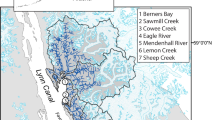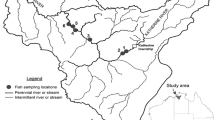Abstract
We surveyed fish assemblages from Blackwater River drainage (Cambridge, Maryland, USA) to assess spatiotemporal patterns of fish distribution in response to salinity intrusion of freshwater wetlands. Three sites spaced along a longitudinal stream gradient were sampled from each of the Little Blackwater River and Blackwater River from December 2005 to December 2006. Salinity in upstream areas of Blackwater River ranged from 9–12 psu, while in the Little Blackwater River salinity ranged from 0–5 psu. Most of the spatial differences in assemblage structure occurred between upstream sites of Blackwater River, an area influenced by saltwater intrusion from the combined effects of sea level rise and a man-made canal, and upstream sites of Little Blackwater River. Freshwater-dependent fishes (e.g., brown bullhead and black crappie) dominated upstream sites of Little Blackwater River, whereas euryhaline species (e.g., killifish and silversides) dominated upstream sites of Blackwater River. We used the Little Blackwater River as a reference system to test the hypothesis that remnant freshwater-dependent fish populations of transitional areas in the Blackwater River may have declined as salinity levels increased. Upstream habitats of Blackwater River were brackish, while such habitats of Little Blackwater River were more persistently freshwater. As salinity increased seasonally in the Little Blackwater River, the abundance of freshwater-dependent fishes declined at two sites. Differences in species diversity and composition between Blackwater River and Little Blackwater River are likely associated with higher salinity and connectivity in upstream portions of the Blackwater River.
Similar content being viewed by others
Literature Cited
Beck, M. W., K. L. Heck, K. W. Able, D. L. Childers, D. B. Eggleston, B. M. Gillanders, B. Halpern, and others. 2001. The identification, conservation and management of estuarine and marine nurseries for fish and invertebrates. Bioscience 51: 633–41.
Benson, N. G. 1981. The freshwater inflow to estuaries issue. Fisheries 6: 8–10.
Carpenter, S. R., S. G. Fisher, N. B. Grimm, and J. F. Kitchell. 1992. Global change and freshwater ecosystems. Annual Review of Ecology and Systematics 23: 119–39.
Chesney, E. J., D. M. Baltz, and R. G. Thomas. 2000. Louisiana estuarine and coastal fisheries and habitats: perspectives from a fish eye’s view. Ecological Applications 10: 350–66.
Dekar, M. P. and D. D. Magoulick. 2007. Factors affecting fish assemblage structure during seasonal stream drying. Ecology of Freshwater Fish 16: 335–42.
Froese, R. and D. Pauly (eds.). 2008. FishBase. World Wide Web electronic publication. www.fishbase.org, version (01/2008).
Garcia, A. M., J. P. Vieira, and K. O. Winemiller. 2001. Dynamics of the shallow-water fish assemblage of the Patos Lagoon estuary (Brazil) during cold and warm ENSO episodes. Journal of Fish Biology 59: 1218–38.
Gotelli, N. J. and G. R. Graves. 1996. Null Models in Ecology. Smithsonian Institution Press, Washington, DC, USA.
Hare, J. A. and K. W. Able. 2007. Mechanistic links between climate and fisheries along the east coast of the United States: explaining population outbursts of Atlantic croaker (Micropogonias undulatus). Fisheries Oceanography 16: 31–45.
Kraus, R. T. and D. H. Secor. 2004. Dynamics of white perch Morone americana population contingents in the Patuxent River estuary, Maryland USA. Marine Ecology Progress Series 279: 247–59.
Kraus, R. T. and D. H. Secor. 2005. Application of the nurseryrole hypothesis to an estuarine fish. Marine Ecology Progress Series 291: 301–05.
Lee, D. S., C. Gilbert, C. Hocutt, R. Jenkins, D. McAllister, and J. R. Stauffer, Jr. 1980. Atlas of North American Freshwater Fishes. North Carolina State Museum of Natural History, Raleigh, NC, USA.
McCune, B. and J. B. Grace. 2002. Analysis of Ecological Communities. MjM Software Design, Gleneden Beach, OR, USA.
McCune, B. and M. J. Mefford. 1999. PC-ORD. Multivariate Analysis of Ecological Data, Version 5. MjM Software Design, Gleneden Beach, OR, USA.
Michener, W. K., E. R. Blood, K. L. Bildstein, M. M. Brinson, and L. R. Gardner. 1997. Climate change, hurricanes and tropical storms, and rising sea level in coastal wetlands. Ecological Applications 7: 770–801.
Murdy, E. O., R. S. Birdsong, and J. A. Musick. 1997. Fishes of Chesapeake Bay. Smithsonian Institution Press, Washington, DC, USA.
Najjar, R. G., H. A. Walker, P. J. Anderson, E. J. Barron, R. J. Bord, J. R. Gibson, V. S. Kennedy, and others. 2000. The potential impacts of climate change on the mid-Atlantic coastal region. Climate Research 14: 219–33.
Roessig, J. M., C. M. Woodley, J. J. CechJr, and L. J. Hansen. 2004. Effects of global climate change on marine and estuarine fishes and fisheries. Reviews in Fish Biology and Fisheries 14: 251–75.
Rogers, C. E. and J. P. McCarty. 2000. Climate change and ecosystems of the mid-Atlantic region. Climate Research 14: 235–44.
Rohde, F. C., R. G. Arndt, D. G. Lindquist, and J. F. Parnell. 1994. Freshwater Fishes of the Carolinas, Virginia, Maryland, and Delaware. University of North Carolina, Chapel Hill, NC, USA.
Ross, S. J. 2002. The Inland Fishes of Mississippi. University Press of Mississippi, Oxford, MS, USA.
Searcy, S. P., D. B. Eggleston, and J. A. Hare. 2007. Is growth a reliable indicator of habitat quality and essential fish habitat for a juvenile estuarine fish? Canadian Journal of Fisheries and Aquatic Sciences 64: 681–91.
Titus, J. G. 1988. Greenhouse effect, sea level rise, and coastal wetlands. Environmental Protection Agency, Washington, DC, USA. EPA-230-05-86-013.
Traut, B. H. 2005. The role of coastal ecotones: a case study of the salt marsh/upland transition zone in California. Journal of Ecology 93: 279–90.
Van Den Avyle, M. J. and M. A. Maynard. 1994. Effects of saltwater intrusion and flow diversion on reproductive success of striped bass in the Savannah River estuary. Transactions of the American Fisheries Society 123: 886–903.
Author information
Authors and Affiliations
Corresponding author
Rights and permissions
About this article
Cite this article
Love, J.W., Gill, J. & Newhard, J.J. Saltwater intrusion impacts fish diversity and distribution in the Blackwater River drainage (Chesapeake Bay watershed). Wetlands 28, 967–974 (2008). https://doi.org/10.1672/07-238.1
Received:
Accepted:
Issue Date:
DOI: https://doi.org/10.1672/07-238.1




